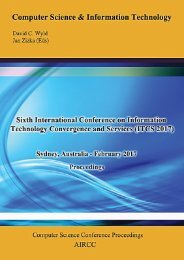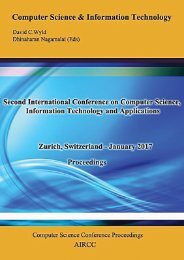CoSIT 2017
Fourth International Conference on Computer Science and Information Technology ( CoSIT 2017 ), Geneva, Switzerland - March 2017
Fourth International Conference on Computer Science and Information Technology ( CoSIT 2017 ), Geneva, Switzerland - March 2017
You also want an ePaper? Increase the reach of your titles
YUMPU automatically turns print PDFs into web optimized ePapers that Google loves.
Computer Science & Information Technology (CS & IT) 61<br />
2.2. Investment into AI and Machine Learning<br />
As a result of this positive news mentioned above, and the lead of many of the top tech company<br />
CEO’s mentioned in [2], a significant financial round of investments has, and continues to be<br />
made, in this area. The market research company Forrester report that across all businesses,<br />
there will be a greater than 300% increase in investment in AI in <strong>2017</strong> compared with 2016 [3].<br />
2.3. Timeline to AGI<br />
The reporting and investment mentioned above have led to widespread speculation as to, “where<br />
is this is all leading to?” And specifically, if the advent of “Superintelligent”, Artificial Generic<br />
Intelligence (AGI) is on the foreseeable horizon. In 2015, the Machine Intelligence Research<br />
Institute compiled the MIRI AI predictions dataset, a collection of public predictions about<br />
human-level AGI timelines. Interesting features of the dataset include the result that the median<br />
dates at which people’s predictions suggest AIG is less likely than not and more likely than not<br />
are 2033 and 2037 respectively. That is perhaps within 20 years. See Figure 2.<br />
2.4. AI as the Singularity Hypothesis solution to Existential Risks<br />
Several high profile scientists and philosophers have made their opinion on the issue mentioned<br />
above clear, optimistic and pessimistic, more about the pessimistic contributions will be<br />
mentioned in section 3 below. However, in the optimistic context of the promise of AI, and AGI<br />
in particular, much is suggested as opportunity to be sought by their agency. E.g., in their facility<br />
to help us to solve existential crises currently confronting humanity (such as Climate Change,<br />
Stabilisation of World Markets, Abundance of material needs, such as food, water and shelter,<br />
plus universal access to Healthcare and Education). The extreme optimistic positioning is that<br />
AGI, and the “Technology Singularity” will be humanity’s last necessary invention, and once<br />
arrived a new age will ensure with material abundance for all, and solutions to humanity’s<br />
problems [11].<br />
2.5. Asilomar Conference <strong>2017</strong>, World Economic Forum <strong>2017</strong><br />
The Future of Life Institute, recognising the above opportunity, and in an attempt to offset<br />
negative pessimism about the downside of AGI, set out principles at the <strong>2017</strong> Asilomar<br />
conference, fundamentally a manifesto and guideline set of rules for the ethical development of<br />
AGI [12]. The explicit message is that action needs to be taken now to intercept any negativity<br />
and deliver positive result.<br />
Similarly, the World Economic Forum, a high-profile international organisation whose stated<br />
mission is to “improve the state of the world”, via Public-Private cooperation, continued on 17-20<br />
January <strong>2017</strong> in its “exploration” on how developments in AI and Robotics could impact<br />
industry, governments and society in the future. Seeking to design innovative governance models<br />
to ensure that their benefits are maximised and the associated risks kept under control. The<br />
emphasis is that AI is coming, it is inevitable, and action has to be taken to ensure it arrives in<br />
good order [13].





